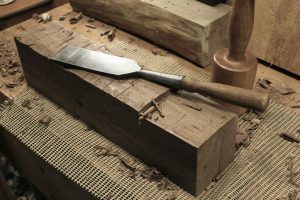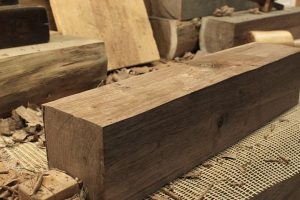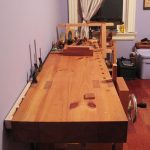We may receive a commission when you use our affiliate links. However, this does not impact our recommendations.
Though planes have been around for millennia, they haven’t always been the essential woodworking tool that we may think they were. In Medieval Europe, and especially England, lots of good woodwork was done without handplanes. Surfaces were prepared and smoothed with wide chisels.
I often use chisels rather than saws or planes, to quickly remove stock. The example above is leg stock for a coffee table I’m making. I needed to remove a good 1/2″ to finish squaring up this stock. I could have sawed this material off, but at nearly 4″ thick, I didn’t think that would be too fun to saw or hold. I could have planed it down, but that would have taken too long. So I cross cut some “breaks”, saw cuts who purpose is to prevent wood from splitting beyond my gaged line, then I simply split off the excess with a 2″ framing chisel. You can control the depth of the split somewhat by using the chisel flat side down (for deeper cuts) or bevel side down for shallower.
I tend to smooth as I go by paring away any irregularties. In just a few minutes of splitting and paring, I was within 1/16″ to my scribed lines. Honestly, I’ll finish this surface with a plane. But it’s easy to see how you could work for a few minutes more and really have a respectable finished surface.
The resulting surface is pretty smooth and pretty flat. This is minutes of work. 18″ long, 4″ wide.
I think this is one of those tricks every woodworker should have up his sleeve. It really is amazing can quickly and accurately you can prepare stock with a chisel. Try it! It may get you out of a jam sometime! Certainly helped me today.
Here are some supplies and tools we find essential in our everyday work around the shop. We may receive a commission from sales referred by our links; however, we have carefully selected these products for their usefulness and quality.











Great Post Adam. Using a chisel & saw for the rough work followed by using a handplane to fine tune sounds like a good two step technique.
Merry Christmas
AL
http://www.woodworkingwithajo.com
thank you for this post, i’m quite interested in medieval woodworking.
is not a plane merely a holder for a chisel? sufficient skill with a chisel should approach the results with a plane (idealogically, anyway. *I* certainly don’t have that level of skill)
As to carpentry vs cabinetmaking, i understand. Though I think the distinction depends on the level of the craft in a given area. If you are getting your stock from a mill, the sizing is already somewhat close. If you are getting your stock from a tree, you’ve got to do the entire process…
It takes a little time to learn to ride the bevel as it were, but my wider chisels are often my smoothing plane for those little bits of tearout that happen sometimes. A plane is just a chisel in a jig – sometimes it’s easier to deal without the jig. I don’t profess to be a master, but it’s satisfying to know with a little finesse, a knife or a chisel can get you a really nice surface, particularly on curved work. I had to make a replacement arm for my bowsaw (poor choice of wood last time) and I don’t think I did all the work with chisels, knives and a cross cut saw.
Carvers do something similar with “break” or “stop” cuts. It’s also a typical medieval hewing technique. As applied to furniture, it can be an effective method.
In my mind it feels like carpentry tho, not cabinetmaking. My guess is, if we had the opportunity to view activities in an 18th c cabinetshop, we’d see a lot more stuff like this. The few shops I have any detailed information about did tend to take on a wide variety of projects, some seemingly more house joinery than cabinetry.
Adam,
Great tip. The stopping cuts should have been a no-brainer for me, but I don’t think I would have thought of it before running a chisel too deep, you just saved me a future mistake!
Great to see a new blog entry from you, I look forward to your tips and techniques on hand work. If you had time for several of these a month we would all eat them up.